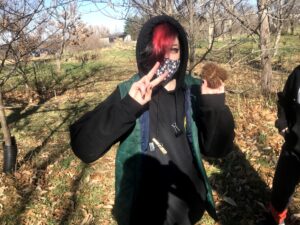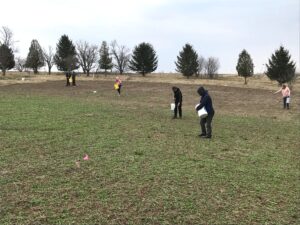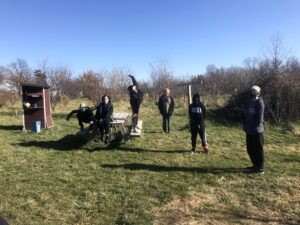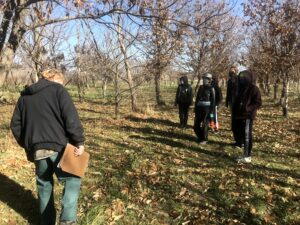Final report for YENC20-153
Project Information
In a Fall 2019 Agriculture and Climate Change class, students studied ways to make Scattergood's certified organic school farm more resilient to the impacts of climate change as well as incorporating ways to combat it. They recognized that native plants and food-producing perennials are an effective combination.
What we taught about sustainable agriculture:
This project had several different phases. First we had to kill the existing pasture species and then sow the intended native understory species. During the summer of 2020 we rototilled the area several times to kill the brome that was there. We also unintentionally propagated some sour dock that students helped dig and remove later in the fall.
The area was sited by our middle school students, who determined the final number of trees that we would purchase and plant. High School Biology Class students worked with Sarah Foltz Jordan of the Xerces Society to come up with a diverse mix of appropriate native plants for the understory, and consulted with Tom Wahl of Red Fern Farm and Dean Henry of the Berry Patch Farm to formulate a list of possible fruit tree species to plant. Shortages of tree stock due to COVID put the planting schedule behind one year, but the Middle School students were able to sow the understory mix late winter 2021.
Informal species census were taken periodically by several classes, and we continued to mow the area several times during spring and summer 2021.
In March and April 2022 several different classes, made up mostly of Middle School students and High School Farm Team students then sited, planted, protected with shelters and watered the trees. We planted 50 trees total including Asian Pears, hazelnuts, tart cherries, sweet cherries, plums, apricots, quince and medlar. Later we added a row of berries that included blueberries, currants, goose berries, honeyberries, aronia berries and service berries. Frequently various classes were involved in irrigating, weeding and checking on the new trees. When students left for the summer, we used drip irrigation to keep the trees watered.
Our Educational Approach:
Throughout the process students had considerable hands-on learning experiences as we planted and maintained the trees. Early in the process we made a field trip to Red Fern Farm to see some of these crops in production. They also had additional learning opportunities as we studied the various fruit types and mapped out the potential timeframes when they would come into production. Students also considered the seasons the fruit would be available and what would be the best uses for the fruit in serving our community.
Statement of Conclusions:
Students were a significant part of this project from start to finish and have learned much about site preparation, native plant establishment, tree selection, planting, protecting and maintenance. All of this was learned in the context of growing perennial foods in a time of climate disruption and working to sequester carbon.
Resulting Actions:
Several students have discussed tree plantings at their homes and their intention to diversify their plantings to include more edibles.
This project will provide students with hands-on experience in native plant restoration and agroforestry, including:
Organically removing established introduced plants through tillage and cover cropping,
Working with experts from the Xerces Society in selecting and seeding geographically and functionally appropriate native species,
Working with experienced farmers in selecting and transplanting food-bearing perennials,
Presenting information effectively through signage at the orchard site,
Educating our immediate and extended community through tours, presentations, social media, and a field day.
Cooperators
Educational & Outreach Activities
Participation Summary:
Update on Outreach activities:
In 2021 we hosted a Practical Farmers of Iowa Catching Up field day and a ISU Extension/Practical Farmers of Iowa field day. We also hosted a beginning farmer tour. For all three events, we discussed the SARE grant, the planned Uncommon Orchard, and other aspects of the farm with each group. Group size was kept small because of COVID, but over 50 people combined attended the 3 events.
We may be hosting a field day in the fall of 2021 (we are unsure of whether it will be in person or not) for another project we have going on with Iowa State University Horticulture and tie in with Practical Farmers of Iowa programming. This is in process. I told Ajay Nair at ISU that we would also like to feature this SARE project in the field day (though it will certainly be "in process"), and he was agreeable.


Learning Outcomes
agroforestry, pollinator habitat, native species, carbon sequestration, biodiversity

